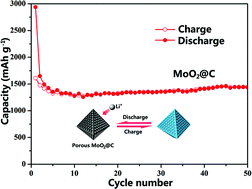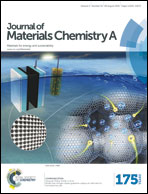Preparation of porous MoO2@C nano-octahedrons from a polyoxometalate-based metal–organic framework for highly reversible lithium storage†
Abstract
Molybdenum oxide has been investigated as a host material for lithium-ion batteries due to its high theoretical capacity (838 mA h g−1), low electrical resistivity, high stability and high electrochemical activity toward lithium. However, a dramatic volume expansion occurred during the charge/discharge process, which results in anode pulverization and thereafter a rapid capacity fading and limits its application as an anode material. Herein, we report the preparation of MoO2 nanoparticles embedded in a porous octahedral carbon matrix (denoted as MoO2@C) by using a polyoxometalate-based metal–organic framework (PMOF) as the precursor. This facile strategy ensures the in situ formation of a porous carbon matrix which could increase active sites to store redox ions and enhance the ionic diffusivity of the encapsulated MoO2 nanoparticles. Benefiting from such unique structures, the MoO2@C composite is capable of delivering a high reversible specific capacity of 1442 mA h g−1 after 50 cycles at a current density of 100 mA g−1 and 443.8 mA h g−1 after 850 cycles at a current density of 1000 mA g−1 as an anode material.


 Please wait while we load your content...
Please wait while we load your content...